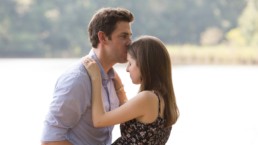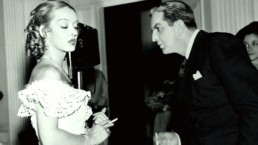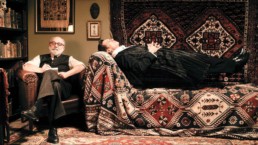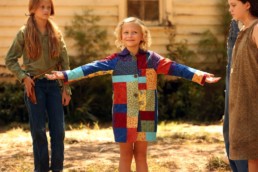John Krasinski Talks "Lottery Ticket Life" in Directorial Debut 'The Hollars' [LISTEN]
[soundcloud url="https://api.soundcloud.com/tracks/279742266" params="color=ff5500&auto_play=false&hide_related=false&show_comments=true&show_user=true&show_reposts=false" width="100%" height="166" iframe="true" /]
Soon after a select group of journalists file into their seats for “The Hollars” press day at the London West Hollywood Hotel, award-winning actress Margo Martindale enters the room with such a warm presence while engaging in small talk with the intimate group, making everyone more at ease. A few moments later, the director and lead protagonist of the film, John Krasinski, makes his way to his chair with a warm smile, twinkling eyes, and perfectly coiffed hair. Despite having just flown in from San Francisco the night before and holding interviews all day for varying websites and publications, the duo seemed relaxed and eager to share the heart and soul that went into the making of this film. Krasinski answers questions with sincerity and humor while Martindale discusses her process with such fondness that we know the relationships we see in this film were not forced or phony... but the result of the cast really bonding and connecting to the universal themes of the film. We begin:
I've never laughed and cried so much in one movie.
John Krasinski: Thank you, that's such a great compliment!
John, did you always plan to both act and direct?
JK: I signed on as an actor about six or seven years ago, and I don't think I've ever signed on to anything so fast. There are a lot of "family movies" out there and I had no intention of being in a "family movie" until I read Jim [Strouse's] script and realized that's the way to tell a family story. I signed on immediately. Four years later, as often happens with these smaller movies, the financier at the time couldn't get it made and asked if I'd buy the script outright. It was a big undertaking but I didn't hesitate with this one because the script was so good.
What have you learned from other directors over the years?
JK: I was a waiter when I got cast in "The Office." I truly believe I got a "lottery ticket life," I don't feel that I deserve it, I feel like I'm trying to deserve staying here. In order to do that, every second of every day I was trying to learn and get better. I'd watch those writers and see how the writer's room worked, watch those directors. As far as the film, I learned from everybody. I remember George Clooney telling me two things: one, you can always make a bad movie out of a good script but you can never make a good movie out of a bad script. Two, the best idea ends up on screen, no matter whose it is. It doesn't matter if it's the person closing up the studio at night, making a film is a team effort.
Margo, what was it like having a director that also spoke the actor's language?
Margo Martindale: He was a dream as a director, the [transition from] actor to director was very seamless. John gave lots of time between takes, he never called "Cut." He's terrific, he knew the movie he wanted to make.
"Margo is one of those people that if you can be anywhere near her in a movie, you'll get better." - John Krasinski

What was the biggest challenge for you, John, taking on the role of actor and director on this project?
JK: This one was really easy to be honest! And I don't mean that to sound obnoxious or anything. It was actually vital for me to be an actor in my opinion. The most important thing in this movie is that you have to feel like you're a family, it had to feel like your hometown. I think there's something that was universally connecting about this script, and I don't know how it happened, but we just became that family. I've had as deep of conversations with Margo and Richard [Jenkins] than I've had with my real family. It was a beautiful thing. To be the actor not having to call cut, like Margo was saying, we'd have small intimate conversations. The beauty of having great actors is, they're the first person to tell you, 'I didn't hit that,' or 'Let's go again.' If I just right now called 'Cut' walked out of the room and came back 10 minutes later, this interview would be weird.
Laughter
JK: I felt the same way about those scenes. I wanted them intimate, in a bubble. That was the beauty of being the actor and director in this situation.
Margo what drew you to this project?
MM: The script, it was honest, surprising and edgy... a messy look at life and family. John asked me if I'd do it, and I was there!
JK: Margo is one of those people that if you can be anywhere near her in a movie, you'll get better. She makes you better because you don't act, you only react. In one of the most emotional scenes of the movie when she finally breaks down, I tell people all the time that was the first and only take we did of that. What she did was so personal, vulnerable, and primal in a way that I don't think any of us were prepared for. So when you go back and watch the movie again, because let's be honest, of course you will...
Laughter
JK: ... You'll see all the actors in that scene have no idea what to do with the performance she gave us. It was more honest than any of us could have understood.
"In all of my scenes, behind every acting performance, I was thanking her through my eyes for doing this." - John Krasinski

How did you get along with Anna Kendrick, acting alongside and directing?
JK: Anna is a true professional. I think something people don't know about Anna is that she was shooting "Pitch Perfect 2" every single day that we were shooting, so on her only day off, she drove from New Orleans to Jackson, Mississippi to be in our movie. That says two things: one, she is dedicated to her job. Two, she supports films like this, and that's a very important thing for her. That essence comes out in everything you do with her. In all of my scenes, behind every acting performance, I was thanking her through my eyes for doing this.
You were making this film while you were becoming a father. Does any of your character's feelings of not wanting to be a failure to another person affect you personally, and vice versa?
JK: 100%. The only other scene that I wrote is between me and Anna in the hospital. When I signed on to act six or seven years ago, I obviously didn't have kids. When I started shooting as a director, my daughter was four and a half months old. So to say that my understanding of the script was vastly different was the biggest understatement of the century. Yes, I understood the idea of a man at the doorstep of being a father, but more than that, I understood the sort of magic, existential connection between family. I understood my parents better after having a baby. I started thinking about having a family name, lineage, big things like that. My dad is my hero in every single way, and if I can be a quarter of the guy he is, then I win.
"I try to spend every single second I can with my kids, and I mean every single second." - John Krasinski

As a working dad, actor, and director, has this film taught you anything about being present for your own family?
JK: One of the sacrifices and there are very few– but let's be honest, this is like fantasy camp, this life is not real, to say I have complaints about it is insane– when you do go away [for work] you go away for awhile. I'm not the first actor who's raised a family so I know there are other people who have done it before me. I'm not unique or special to this situation, so I try to spend every single second I can with my kids, and I mean every single second. When I'm not working, I'm at home and it's the best!
What's next for the both of you?
JK: I'm doing the "Jack Ryan" TV series for Amazon, which I'm really excited about taking on a character that I loved my whole life!
MM: I'm doing a series for Amazon right now call "Sneaky Pete," a Bryan Cranston creation with Giovanni Ribisi...
JK: This press conference is sponsored by Amazon, haha.
'The Hollars' Showcases Family Dysfunction With Humor and Sincerity
John Krasinski takes on the role of both actor and director with genuine sincerity in his second directorial endeavor, "The Hollars." Honest performances from a critically acclaimed cast, coupled with an earnest script from James C. Strouse, make "The Hollars" one hilarious and bittersweet film that will pull at your heart-strings.
John Hollar (John Krasinski), a struggling NYC graphic novel artist, is told by his pregnant girlfriend Becca (Anna Kendrick) that he needs to fly home because his mother Sally (Margo Martindale) has been diagnosed with a brain tumor. Upon John’s return home, he finds that all the drama and dysfunction he left behind are not only still present, but have increased exponentially. We meet John’s screw-up, unemployed divorcee brother Ron (Sharlto Copley) and his overly emotional and soon-to-be bankrupt father, Don (Richard Jenkins). Jason (Charlie Day), the feisty nurse treating his mother, happens to be married John’s high school girlfriend Gwen (Mary Elizabeth Winstead) who is still very much in love with him. Throughout the rollercoaster of each family member’s own personal crisis, Sally remains the anchor of her family in spite of her own regrets and fears.
Ok, real talk 2016. I read a few reviews before seeing this film. Why all the hate? (I’m looking at you Variety). I found this film to be DE-LIGHT-FUL! I laughed. I cried. I never looked at my watch. (yeah I know it’s 2016, we have clocks on our phones and no one wears watches… YOU KNOW WHAT I MEAN). Sure, one could argue that a situational family dramedy has been done before, and perhaps some of the plot lines could be perceived as weak or superfluous. And yes, it reminded me of a less pretentious/sulky "Garden State" minus the obnoxious manic-pixie-dream-girl trope. BUT I DIGRESS… Let’s get to why this movie is legit.
Number one– John Krasinski is extremely charming. Number two– The ensemble cast is an absolute revelation. They navigate the challenging comedy-to-drama hairpin turns of Jim Strouse’s script with style and grace. They are never a caricature or overly archetypal, but rather, they approach their characters with sincerity and a realness that only true professionals can bring to the table. Number three (and most importantly)– This film does such a superb job of showcasing a truly sad but very real situation and combining it with the absurdity of family dysfunction. It is so relatable. We all can relate to having weird, messed-up families. We can all sympathize with loved ones getting sick. We have all dealt with getting the wind knocked out of us when life GETS REAL, whether it’s a failed business or relationship or a dream that just never came true and NOW it’s time to grow up.
Krasinski successfully tells a story that surpasses the trope of just another generic family dramedy and brings us a wacky but heartfelt film. "The Hollars" will strike a personal chord with the audience by resonating as authentic, funny, and tragic, and these realistic aspects are something that we have all experienced in some capacity in our own lives.
"The Hollars" is rated PG-13 for brief language and some thematic material. 105 minutes. Opens Friday, 8/26, at The Landmark.
'Women He's Undressed' is Bursting at the Seams With Style, Scandal, and Old Hollywood Glamour
Inspired by the recently published posthumous, long-lost memoir of the prolific Hollywood costume designer, Orry-Kelly, Australian director Gillian Armstrong (My Brilliant Career,” “Charlotte Grey”) sews together a historically informative and whimsical documentary in “Women He’s Undressed.”
The film follows the life of Australian-born Orry George Kelly, from his humble beginnings as an aspiring artist and failed bank clerk to the rise of his prolific career in costume design. Orry-Kelly dressed the biggest stars in 282 Hollywood films. The designer went on to become a three-time Academy Award winner for his ingenious work in “An American in Paris,” “Les Girls,” and “Some Like It Hot.”
The gowns that Orry-Kelly designed are so breathtakingly beautiful, it makes one want to absolutely bathe in them. More impressive than the glamour was his ability to structure clothes in a way that complimented even the most challenging figures. As costume historian Deborah Nadoolman Landis says, he was simply “a master of silhouette and nuance.” Kelly worked closely with the actors and created costumes that not only made them look their best, but also truly brought the character to life. Jane Fonda noted that Kelly “built clothes specifically for this character. For you.”
The film does not go without highlighting a fair share of scandal that followed this brilliant designer. Notorious for being outspoken, Kelly was unashamed to be himself and quite open about his sexuality in a time when homophobia ran rampant and being gay was not only taboo but also illegal. In addition, the film spends some time focusing on Kelly’s intimate relationship with his former “roommate” and aspiring actor Archibald Leach, who we later discover turns out to be leading man, Cary Grant.
Armstrong makes a bold choice in this documentary by combining a mixture of traditional talking head interviews and a series of highly stylized re-enactment scenes. This could be perceived as a distracting, campy misstep or as a unique and engaging way to enhance the subject matter. Personally, I would love to see those reenactments turned into a stage play.
Many of Orry-Kelly’s peers and clients are now deceased. However, Armstrong has tailored the film to a wonderful group of interviewees ranging from film historians (Leonard Maltin and David Chierichetti), designers (Ann Roth, Colleen Atwood, and Catherine Murray), and Hollywood royalty (including the scene-stealing Jane Fonda).
“Women He’s Undressed” is playful and thought-provoking, packed with historical tidbits. Armstrong expertly weaves together the life of the designer with the context of the Hollywood film industry spanning from the 1930s to the time of Orry-Kelly’s death in the early 1960s. Gillian Armstrong has created a film that is a must-see for fashionistas and film buffs alike.
“Women He’s Undressed” is not rated. 95 minutes. Now playing at the Arena Cinema in Los Angeles and will be released on DVD / VOD on Tuesday, August 9th.
'Therapy for A Vampire' is a Comedy Worth Sinking Your Teeth Into
Living in eternal darkness can get anyone down, especially for an undead blood-sucking Count in David Rühm's "Therapy for a Vampire." Following in the footsteps of films such as "What We Do in The Shadows", "Therapy" is a quirky but fresh take on a subject that normally presents itself as self-serious and macabre.
The story is set in Vienna, 1932. Count von Közsnöm (Tobias Moretti) has lost his thirst for life and the ability of self-reflection. After making a generous donation to the analyst’s society, the Count convinces the acclaimed psychoanalyst, Dr. Sigmund Freud (Karl Fischer), to take him on as a new patient. The Count is bored with a 500-year long marriage to his vicious, blood-thirsty wife, Countess Gräfin Elsa von Közsnöm (Jeanette Hain), whose own vanity drives her obsession to once again see her reflection. To distract his wife, the Count suggests the Countess commissions a portrait of herself by Freud’s assistant Viktor (Dominic Oley). Coincidentally, this aspiring painter’s headstrong girlfriend, Lucy (Cornelia Ivancan) catches the eye of the Count and he becomes convinced that she is a reincarnation of his long lost muse, Nadilla. Although Lucy and Viktor appear to be the solution to their problems, only jealousy and shenanigans ensue for the cursed couple.
The campy theatrics and jabs at familiar vampire lore provide plenty of belly laughs as the characters tumble through this mortal-on-immortal love triangle - er- love hexagon? Writer/Director David Rühm has an imaginative take on the vampire legend, in addition to, crafting his characters as three dimensional and charmingly flawed. A prime example is our leading lady Lucy. She is no damsel in distress or prize to be won. There is a reoccurring theme of the men pining over her and trying to make her conform to their ideal fantasy girl. However, this spunky waitress is having none of it. The story flows smoothly with enough twists and turns to keep the audience wondering what will happen next.
Additionally, did we mention this film is completely in German? Never fear, with the energetic pace and expressive performances by the talented cast, one completely forgets that they are reading subtitles. In fact, the foreign language adds to the delightfully stylized Baz Luhrmann meets Tim Burton aesthetic and vibrant yet gothic tones. The gorgeous costumes, set-pieces, and blood baths completely immerse the viewer into this 1930s Viennese vampire world. "Therapy for a Vampire" proves to be a hilarious and wildly entertaining take on vampire lore and undead love.
"Therapy for a Vampire" is unrated. Playing at the Nuart Theatre Los Angeles on Friday, 6/10.
'Already Tomorrow In Hong Kong' Plays Like a Two-Hour OKCupid Date
Already Tomorrow In Hong Kong plays less like a will-they-won’t they romance and more like a two-hour OKCupid date with small talk and minimal chemistry.
The film opens with Ruby (Jamie Chung), an Angeleno visiting Hong Kong for the first time sans GPS, unable to locate her friends. As fate would have it, Josh (Bryan Greenberg), an expat New Yorker who has been living in Hong Kong for nearly a decade, offers to guide her to meet her friends.
As they walk, they talk about where they are from, their respective disconnect to their heritage, what they do for a living, and what they wish they were doing instead. Not exactly gripping. As they are about to reach their destination, Ruby decides to bail on her friends and asks Josh to join her for a drink. Perhaps this is where the sparks will really fly. However, the evening ends abruptly when Ruby realizes Josh has not been forthcoming with certain details of his life.
Exclusive Clip:
One year later, by chance, the two cross paths again in Hong Kong on a ferry to Kowloon. After the two make amends for the unpleasantness of their previous parting, they take an extremely long walk and catch up on how their lives have changed over the course of the year. Ruby is now living in Hong Kong full time. Josh who had followed Ruby’s advice a year prior has left his cushy job in finance to write a novel. Both are in complicated relationships. The attraction is still there. The film ends leaving us in suspense, will they follow their hearts or will they be mature and just be Facebook friends?
The most charming performance of the film is delivered by a cameo from a local street fortune-teller they encounter. The audience does not learn much about the characters, except perhaps that Josh is a 35-year-old man-child who quit his job and now orders Red Bull vodkas and Ruby thinks she is unique and sassy because she enjoys watching reruns of Seinfeld.
Emily Ting makes her directorial debut by creating an enchanting homage to the urban nightlife of Hong Kong while simultaneously tips her hat to the acclaimed film, Before Sunrise. Ting has written dialogue that seems very real, however, nothing about the characters’ relationship suggests it is a once in a lifetime attraction worth derailing the characters’ current paths.
Review: 'The Benefactor'
It is always refreshing when a new storyteller is on the rise in Hollywood. The Benefactor comes as a feature-length directorial debut by newcomer writer/director Andrew Renzi. Well received by film festivals and critics alike, The Benefactor is a suspenseful and intriguing character study of a charming yet overbearing philanthropist who meddles in the lives of a newly married couple in an attempt to relive his past.
The film opens with Franny (Richard Gere) discussing design plans for a children’s hospital project on which he is collaborating with his married college friends Mia and Bobby (Cheryl Hines, Dylan Baker). Unfortunately, Franny's horsing around while driving (with his previously mentioned friends) leads to a fatal car accident.
Five years later, we see Franny sitting alone in a lavish hotel surrounded by bottles of medication and sporting a cane along with an appearance resembling an elderly Howard Hughes. Out of the blue, he receives a call from his late best friends’ daughter, Olivia (Dakota Fanning), whom he lovingly calls “Poodles”. She is pregnant and newly married to Luke (Theo James) a young, handsome doctor who is in need of employment. Franny is revitalized and beyond excited to help out in any way he can.
Without prompting, in addition to securing Luke a job at the children’s hospital he supports, Franny showers the young couple with lavish gifts. Olivia and James quickly learn that all of the expensive gestures come with a price. Franny shows little regard for personal boundaries; the red flags surrounding his shifting intentions begin to alarm Luke.
It becomes more and more clear that Franny is addicted to morphine, which he uses to medicate not only his pain but also his guilty conscience. We watch his descent from charming philanthropist to an erratic and desperate addict.
The film creates an uncomfortable level of tension for the viewer. Along with the rising suspense, The Benefactor almost takes on the direction of a psychological thriller before pulling back in the last scenes- perhaps in an attempt to appeal to a wider audience.
Writer/director Andrew Renzi loosely based the character of Franny on the famed Philadelphia philanthropist, John Dupont, who we all know from Bennett Miller's 2014 critically-acclaimed film Foxcatcher. However in this film, Renzi offers little to no history of Franny- the origins of his wealth remain a mystery. On a similar note, Olivia’s character could have been more fleshed out and interesting if given a backstory. If expanded upon, she could have reflected an opposing extreme to Franny’s approach to coping with the loss of her parents. In comparison to Franny’s isolation and self-destruction, Olivia’s reaction to the sudden tragedy is bottled up emotion paired with a cold exterior. She attempts to fill the void by rushing to adulthood, creating her own family and a sense of stability. It is all there, but would be more compelling if explored further.
The Benefactor premiered at the Tribeca Film Festival last April and has been gaining momentum ever since, going on to win "Best U.S. Narrative Feature Film" at the Catalina Film Festival in 2015. The film proves to be an entertaining and suspenseful watch with engaging performances by the all-star cast, and Renzi is a promising director worth remembering. As he grows and develops as a director, I look forward to what the future has in store for this talented filmmaker.
The Benefactor is out in theatres January 15, 2016. Unrated.
Review: 'Dolly Parton’s Coat of Many Colors'
- I listened to Blue Grass Hymns while writing this review
- It took everything in me to NOT write this in the first person
- I literally cried multiple times while watching the movie
- Dolly and I have apparently both written an essay about why we love Dolly
- Dolly's middle name is Rebecca
- We both sang solos at church
- We were both raised poor but managed to be fabulous and gaudy
- My version of my "coat of many colors" ... and yes that is a cotton field behind me

Considering the seemingly dark state in the world’s current events, Dolly Parton’s Coat of Many Colors comes as a sigh of relief just in time for the holidays. The faith-based “Hallmark-esque” film is not a biopic spanning the entirety of Parton’s performing career, rather it captures a narrow slice of Parton’s childhood during a time when her tight-knit family faced a tragedy that rocked life as they knew it. However, upon discovering the true healing power of faith and love, the Partons’ stitched their family back together like the raggedy coat that Dolly’s mama made for her.
For those of you who are not familiar, Coat of Many Colors is based off of Dolly Parton’s 1971 hit of the same name. The film is set in the gorgeous Great Smoky Mountains of Tennessee in 1955. Before the rhinestones and wigs, little nine-year-old Dolly Parton (Alyvia Alyn Lind) was painting her face with “borrowed” watercolor paints and singing solos in her grandfather’s church on Sundays. Dolly, one of eight children (with one on the way), is precocious, ornery, yet every bit delightful. With a family tradition of the older siblings caring for the younger ones, the young songbird is beyond eager for the arrival of Baby Larry. When Dolly’s mother (Jennifer Nettles), loses the baby and begins to withdraw from the family, Dolly stops singing. Dolly’s faith is tested, as well as the relationship between her parents, who always “had more love than money”.
Quotable one-liners matched with earnest performances truly tug at one’s heartstrings.
Pamela K. Long’s script has various subplots that could easily be interpreted as campy and formulaic. However, the quotable one-liners matched with earnest performances, truly tug at one’s heartstrings. Plus, with over 12 million viewers, the two-hour special based on Parton's autobiographical song was the most-watched film on broadcast networks in nearly four years. If you do not feel ALL the feels, then you might be a heartless sociopath.
Dolly Parton’s Coat of Many Colors will be re-airing on Christmas night and stream for 25 days following its broadcast on NBC.com, NBC apps and Set-Top Box on Demand.
https://www.youtube.com/watch?v=BAtz9x4OfCo







